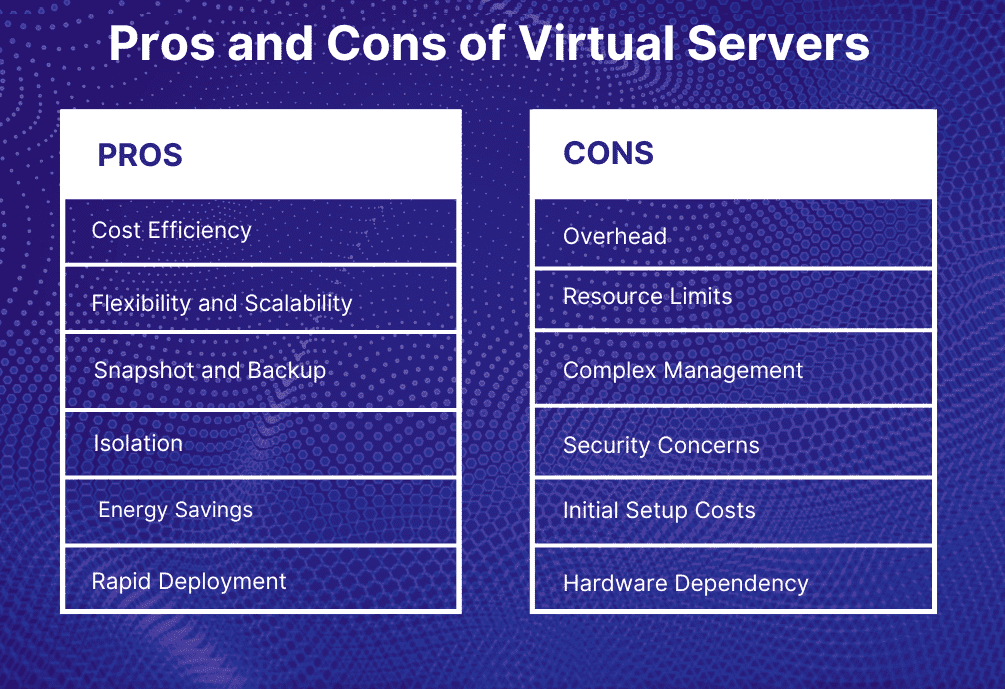Virtualization creates a simulated environment instead of a physical computing environment. Virtualization often includes computer-generated versions of hardware, operating systems, storage devices, and more. This allows organizations to divide a single physical computer or server into multiple virtual servers (Virtual Machines). Each virtual machine can interact independently and run different operating systems or applications, even though they share the resources of a single guest server.
Virtualization scales and improves workloads by creating multiple resources from a single server, reducing the number of hardware used, consuming less energy, and reducing infrastructure maintenance costs.
The biggest investment made by vendors in the field of virtualization is server virtualization solutions. Virtualization types have undergone significant changes in the last ten years, and server virtualization has been the most affected.
Server virtualization technology can now host many types of servers that require significant computing resources. After the evolution, we can perform operations on virtualization platforms that we cannot perform on physical resources.
Horizontal and vertical growth operations can be carried out much faster, more effectively, with less interruption and less cost than on physical platforms. Moving a computer resource running on a virtualization platform is easier and faster than moving a computer resource running on a physical platform. Because of this feature, backup, business continuity, business processes, and disaster recovery policies are easier to create.
Advantages of Virtual Servers
-
Lower cost. Virtual server is a perfect option for small businesses, because they are cheaper than physical servers.
-
Customizable. Users can select operating systems, applications and other features according to their requirements.
-
More secure. Virtual servers use isolation technologies that prevent access to other users' data.
-
Higher performance. Virtual servers use resources more efficiently and are more responsive. This means that users experience a faster website or application.
-
Flexibility. Users can configure virtual servers to suit their needs and use resources more efficiently.
Moreover, when hardware is virtualized, far less resources are needed to manage IT systems. Virtualized environments can also be maintained remotely.
A service on a physical machine will run as long as the server is alive. In the event of a power outage, software or hardware failure, the service will also stop. Virtualization eliminates these situations. Most vendors offer fault-tolerant clusters. If a problem occurs on an HA cluster host, virtual machines are migrated to production hosts.
Disadvantages of virtual servers
Sysadmins should be technically literate to manage VMs and troubleshoot problems.
Virtual servers are not as reliable as physical ones. Although these servers use isolation to prevent access to data, the technologies are not entirely reliable.
Data backup is more difficult in a virtualized environment because more servers, applications and data stores need to be monitored. Most modern backup applications have virtualization features, but you should make sure that these features are a good fit for your environment. With more active servers, it may take longer to back up additional data.
Server security is always an issue, but it becomes even more challenging when protecting virtual servers. The complexity is due to the number of virtual servers in an environment and the variability of their lifespan because they can be so easily deployed and destroyed. A good security application should either provide an up-to-date inventory of virtual servers or work with a virtualization management application that can provide this information.

Why choose virtualization?
When the idea of virtualization was first introduced, the main motivation was economy. The desired success was achieved by moving towards the goal of producing a lot from a single center. With virtualization, one physical server delivers productivity as if it had numerous hardware devices. This is a small revolution in computer technology.
Virtualization technology made it possible to add space for new servers on a single computer. Especially in the age of communication, such requirements have become even more apparent. As a result, users' requirements for physical servers have decreased significantly. This means that very serious costs have been eliminated.
After virtualization, there has been a very serious reduction in CPU usage. In general, physical servers used more than 10% of the CPU. Now, after virtualization, this rate has dropped to around 5%. All of these reasons and benefits should be reason enough to consider virtualization technology. Especially if you run a computer-based company, virtualization will be a very smart choice for you.
There are many areas where virtual servers are used. From corporate websites to online shops, these servers are suitable for medium and large projects. Virtual servers can help to cope with increasing workloads and respond to sudden surges in demand, such as during a sales period.
There are cases directly related to the IT industry. Many programmers deploy application development environments on virtual servers to connect from anywhere in the world.



